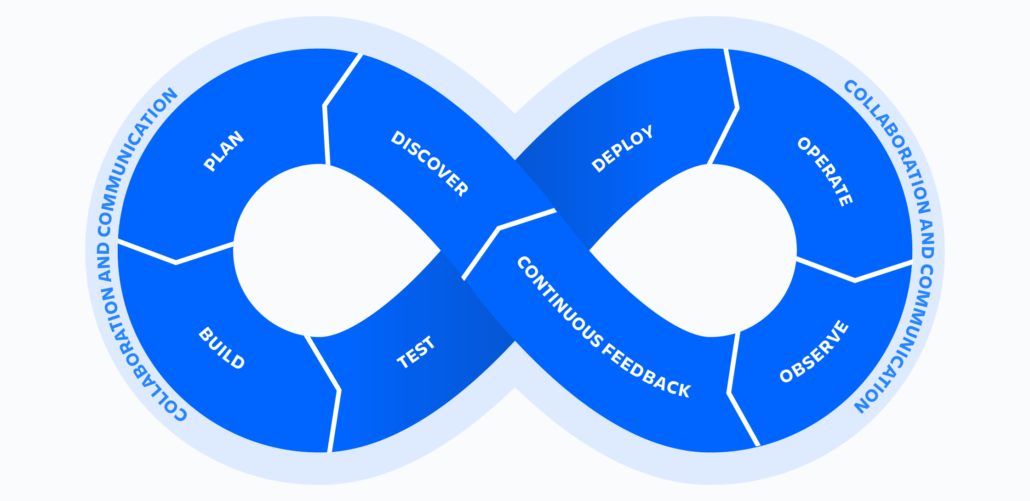Introduction
What Is DevOps?
DevOps constitutes a comprehensive approach encompassing practices, tools, and a cultural ethos, aiming to streamline and unite the workflows between software development and IT teams. At its core, DevOps emphasizes the empowerment of teams, fostering cross-team communication, collaboration, and the implementation of technology-driven automation.
The genesis of the DevOps movement can be traced back to around 2007 when concerns surfaced within the software development and IT operations communities regarding the traditional model. This model maintained a separation between developers responsible for code creation and operations teams tasked with deployment and support. The term “DevOps,” derived from the amalgamation of development and operations, encapsulates the concept of amalgamating these distinct disciplines into a seamless and continuous process.
How does DevOps work?
A DevOps team operates with a collaborative synergy between developers and IT operations throughout the entire product lifecycle, aiming to enhance the speed and quality of software deployment. This approach represents a transformative shift in work culture, carrying substantial implications for both teams and the organizations they serve.
In the DevOps framework, the traditional segregation between development and operations teams is dismantled, often leading to the formation of a unified team. Engineers within this amalgamated team engage in diverse tasks spanning the entire application lifecycle, from development and testing to deployment and ongoing operations, showcasing a broad spectrum of multidisciplinary skills.
To streamline and expedite processes, DevOps teams leverage tools that automate various aspects, contributing to heightened reliability. The deployment of a DevOps toolchain is instrumental in addressing essential DevOps principles such as continuous integration, continuous delivery, automation, and fostering collaboration.
The DevOps philosophy is not limited to development teams; it extends its principles to other units, including security teams. In a DevSecOps approach, security becomes an active and integrated component of the development process, ensuring a holistic and secure software delivery lifecycle.
The DevOps lifecycle

The DevOps lifecycle represents the end-to-end process of software development and IT operations working seamlessly together to deliver high-quality software in a continuous manner. It encompasses various stages from planning and coding to testing, deployment, operation, and monitoring. Here’s an overview of the DevOps lifecycle:
- Planning:
- This initial stage involves defining the objectives, scope, and requirements of the software development and deployment.
- Planning includes creating a roadmap, prioritizing features, and establishing timelines for development cycles.
- Coding:
- Developers write and commit code based on the planned features and requirements.
- Collaboration and version control systems are essential during this stage to ensure the codebase is managed efficiently.
- Building:
- The code is transformed into executable files and binaries in this phase.
- Build automation tools are often used to streamline and standardize the build process, ensuring consistency across different environments.
- Testing:
- Automated testing and continuous integration are key components of the DevOps lifecycle.
- Developers and testers collaborate to identify and fix bugs early in the development process.
- Continuous testing ensures that the code is reliable and meets the specified criteria.
- Deployment:
- Automated deployment tools are employed to release the application to various environments, such as testing, staging, and production.
- Continuous delivery practices enable frequent and reliable releases.
- Operation:
- Once deployed, the software is actively monitored in a production environment.
- Operations teams manage infrastructure, troubleshoot issues, and ensure the system’s stability and performance.
- Monitoring:
- Continuous monitoring is crucial for identifying and addressing issues promptly.
- Monitoring tools provide insights into system performance, user experience, and any potential incidents.
- Feedback and Optimization:
- Feedback from monitoring and user interactions is used to improve future development cycles.
- The DevOps lifecycle is iterative, and continuous feedback helps optimize processes for enhanced efficiency and quality.
The DevOps lifecycle promotes collaboration, automation, and continuous improvement, allowing organizations to deliver software faster, more reliably, and with better adaptability to changing requirements.
